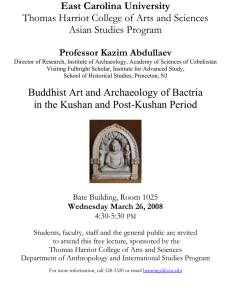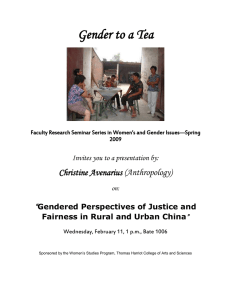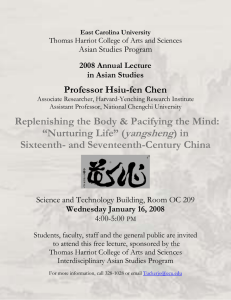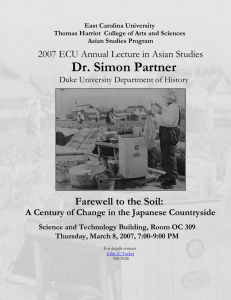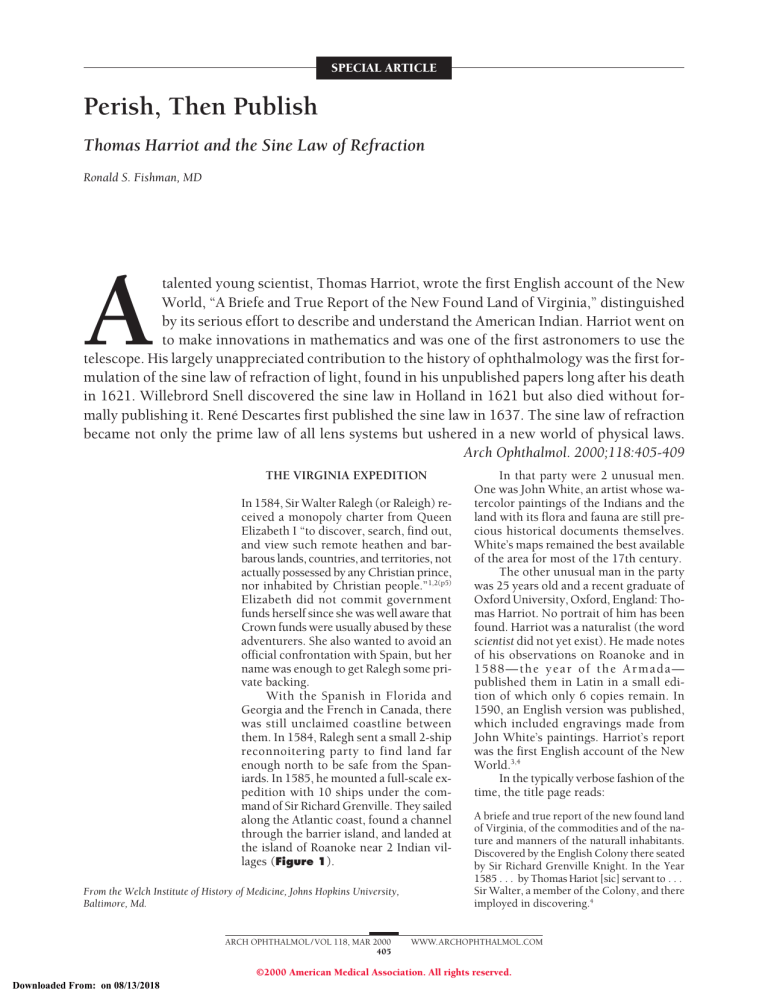
SPECIAL ARTICLE Perish, Then Publish Thomas Harriot and the Sine Law of Refraction Ronald S. Fishman, MD A talented young scientist, Thomas Harriot, wrote the first English account of the New World, “A Briefe and True Report of the New Found Land of Virginia,” distinguished by its serious effort to describe and understand the American Indian. Harriot went on to make innovations in mathematics and was one of the first astronomers to use the telescope. His largely unappreciated contribution to the history of ophthalmology was the first formulation of the sine law of refraction of light, found in his unpublished papers long after his death in 1621. Willebrord Snell discovered the sine law in Holland in 1621 but also died without formally publishing it. René Descartes first published the sine law in 1637. The sine law of refraction became not only the prime law of all lens systems but ushered in a new world of physical laws. Arch Ophthalmol. 2000;118:405-409 THE VIRGINIA EXPEDITION In 1584, Sir Walter Ralegh (or Raleigh) received a monopoly charter from Queen Elizabeth I “to discover, search, find out, and view such remote heathen and barbarous lands, countries, and territories, not actually possessed by any Christian prince, nor inhabited by Christian people.”1,2(p5) Elizabeth did not commit government funds herself since she was well aware that Crown funds were usually abused by these adventurers. She also wanted to avoid an official confrontation with Spain, but her name was enough to get Ralegh some private backing. With the Spanish in Florida and Georgia and the French in Canada, there was still unclaimed coastline between them. In 1584, Ralegh sent a small 2-ship reconnoitering party to find land far enough north to be safe from the Spaniards. In 1585, he mounted a full-scale expedition with 10 ships under the command of Sir Richard Grenville. They sailed along the Atlantic coast, found a channel through the barrier island, and landed at the island of Roanoke near 2 Indian villages (Figure 1). From the Welch Institute of History of Medicine, Johns Hopkins University, Baltimore, Md. ARCH OPHTHALMOL / VOL 118, MAR 2000 405 In that party were 2 unusual men. One was John White, an artist whose watercolor paintings of the Indians and the land with its flora and fauna are still precious historical documents themselves. White’s maps remained the best available of the area for most of the 17th century. The other unusual man in the party was 25 years old and a recent graduate of Oxford University, Oxford, England: Thomas Harriot. No portrait of him has been found. Harriot was a naturalist (the word scientist did not yet exist). He made notes of his observations on Roanoke and in 1588—the year of the Armada— published them in Latin in a small edition of which only 6 copies remain. In 1590, an English version was published, which included engravings made from John White’s paintings. Harriot’s report was the first English account of the New World.3,4 In the typically verbose fashion of the time, the title page reads: A briefe and true report of the new found land of Virginia, of the commodities and of the nature and manners of the naturall inhabitants. Discovered by the English Colony there seated by Sir Richard Grenville Knight. In the Year 1585 . . . by Thomas Hariot [sic] servant to . . . Sir Walter, a member of the Colony, and there imployed in discovering.4 WWW.ARCHOPHTHALMOL.COM ©2000 American Medical Association. All rights reserved. Downloaded From: on 08/13/2018 Figure 1. The island of Roanoke and its approaches in the 1585 expedition to Virginia, reproduced in “A Briefe and True Report of the New Found Land of Virginia,” 4 the first English account of the New World, written by Thomas Harriot. The dedication, written by De Bry, the publisher in 1590, includes 2 pages of fulsome praise for Ralegh with only a slight mention of Harriot and no mention of John White at all. Ralegh himself never crossed the Atlantic at this time. His big sacrifice was financial; he was saved from bankruptcy by Grenville’s capture of a Spanish treasure ship on the way home. Privateering at this time was much more profitable than colonizing. Despite Harriot’s servant status, the book shows a modern mind at work—curious, inquiring, and observant. Harriot inventories the land’s resources, and the whole account is characterized by the same effort shown by the other leaders of the expedition: the urge to show how the land could be commercially exploited, the more quickly the better. Harriot takes note of minerals such as iron ore, but we can assume what a disappointment the meager amount of precious metal is—some copper plates, some silver earrings in an Indian chief’s ears and, worst of all, no gold. True, the climate is good, and the soil is fertile. There are many game animals and many valuable trees that could make masts for ships. The natives are already farmers of peas, barley, oats, and corn (good for making beer). Best of all to the modern sensibility, Harriot shows himself to be a serious student of the Indians’ hab- its, religion, and social organization, writing what would now be called ethnology or cultural anthropology. Harriot actually learns something of the Algonkin Indian language and evidently converses with them after a fashion. He shows them a Bible and tries to explain it, but he is chagrined that it is the physical nature of the book itself that impresses them. And although I told them the book materially and of itself was not of any such virtue, as I thought they did conceive, but only the doctrine therein contained; yet would many be glad to touch it, to embrace it, to kiss it, to hold it to their breast and head, and stroke over all their body with it, to show their hungry desire of that knowledge which was spoken of.3(p761) Here Harriot is deceiving himself. The reaction of the Indians is the same as that of the isolated mountain-dwelling natives of New Guinea during World War II, who ascribed supernatural qualities to the strange contents of crashed cargo planes. Any advanced technology seems like magic to the more primitive one. Harriot also writes: Some people could not tell whether to think us gods or men . . . there was no man of ours known to die, or that was specially sick. [Actually 4 of the 108 Englishmen left at Roanoke for 10 months did die of illness.] . . . They noted also that we had no women among us, neither that we did care for any of theirs.3(p762) ARCH OPHTHALMOL / VOL 118, MAR 2000 406 This is said of a party of unruly men whose leader later described them as “wild men of mine own nation.”1(p11) This scruffy lot of exsoldiers had been away from their homes for many months. They were certainly in the advanced stages of that condition to which the long voyage around Cape Horn (with its extended period of enforced sexual abstinence) was later to give its name. “ . . . [N]either did we care for any of theirs.”? This is such a bare-faced unlikelihood, and since we know that Harriot was not an obtuse man, we assume that he was being deliberately misleading. He was putting the best face on what was essentially an advertising or propaganda brochure. Far from being a true report, the whole book is guarded, selective, remarkable for what it does not say. There is no hint that the colony became a shambles. The gentlemen-adventurers had come for gold, not farming. The party became dependent on the Indians for food, and eventually made enemies of them. After 10 months, the English feared for their lives. Ralegh’s resupply ships were late. When Sir Francis Drake unexpectedly appeared on his way home from a privateering expedition, the party leaped at the chance to leave. Worst of all, the lesson was not learned. Ralegh sent another party of colonists to the New World in 1587. Although this group was recruited from farmers and artisans with skills more useful for sustaining themselves, this group was also undersupplied and unwisely, even treacherously, landed at the same Roanoke site. These were the unlucky souls who inherited the ill will fostered by Harriot’s party. They became known as the lost colony of Roanoke.1,2 As for the Indians, they eventually felt the full civilizing effects of smallpox and other contagion already seeded by the Englishmen. But the adventure was a good career move for Harriot. When he returned to England, Ralegh introduced him to the Earl of Northumberland, and both men supported Harriot’s career as the first English scientist. HARRIOT’S LATER CAREER Harriot never left England again. He remained Ralegh’s friend even after WWW.ARCHOPHTHALMOL.COM ©2000 American Medical Association. All rights reserved. Downloaded From: on 08/13/2018 Ralegh became a victim of the paranoid politics of the time and was for some years imprisoned in the Tower of London. Harriot contributed to Ralegh’s defense in what was a travesty of a trial and visited Ralegh often, bringing books and gossip. He helped Ralegh to get his affairs in order prior to his execution for treason in 1615.5-7 Harriot made many contributions to mathematics, particularly algebra. His notations for greater than, less than, and root of became part of algebraic notation, and there is a Harriot’s Law on the number of roots in an equation. He also made important contributions to the geometry of map making, navigation, and practical seamanship (one of the reasons Ralegh sent him out to sea in the first place), and he wrote on ballistics and practical gunnery.8-10 Most important for this story, Harriot became interested in astronomy. He made the first telescopic map of the moon’s surface, and Harriot’s crater is located on the reverse side of the moon, the side not seen until satellites investigated it, the features of which were named after prominent scientists. Harriot also made many sightings of the major moons of Jupiter, probably before Galileo. He studied sunspots enough to calculate the period of the sun’s axial rotation for the first time. Since he preferred to view the sun directly, usually from behind a thin mist of cloud, he complained once that “my sight was after dim for an houre.”7(p206) Another early astronomer, John Greaves of Oxford, England, after measuring the sun’s diameter complained that “for some days after, to that eye, with which I observed, there appeared, as it were, a company of crows flying together in the air at a good distance.”11(p40) Astronomers eventually learned to view the sun indirectly, but their early days recall the blasé attitude of early radiologists using x-rays. THE PERIL OF PERISHING BEFORE PUBLISHING Although he had ample warning that he should get his affairs in order—it took the cancer in his nose more than 8 years to kill him— Harriot’s papers, other than “A Briefe and True Report of the New Found Land of Virginia,” were unpublished at the time of his death in 1621. Just a few days before his death, probably in agony, he made his will, named his literary executors, and asked them to publish his papers. The executors did a poor job of it. Except for one published book of mathematics, the papers were soon lost. When the Royal Society in London was founded in 1660, its early meetings were full of discussion as to where Harriot’s papers might be. Harriot had made the serious error of perishing before publishing. His ideas played only a small part in the growth of British science. In effect, he had disappeared, and he remained a largely unknown scientific genius until relatively recently.7,12 THE SINE LAW If Harriot’s papers had been published, there would have been one particular gem in them, the most crucial of all optical principles: the sine law of refraction. This relates the angle of incidence (between the incident ray and a line perpendicular to the interface between optical media of differing densities) to the angle of refraction (the angle between the refracted ray and its perpendicular). The ratio between the sines of the 2 angles is a constant, related to the differing speeds of light in the different optical media. This is the physical law basic to all lens systems (Figure 2). Harriot began experimenting with refraction in the 1590s. He annotated a copy of an old book on optics with a table of new refraction values, dated 1597, and these values strongly suggest that he had calculated them by the sine relationship. He probably discovered the sine law before 1602, but neither stated it nor described his technique and reasoning in any extant document. He corresponded with Johannes Kepler about optics from 1606 to 1609, but only in a curiously guarded way, without mentioning the sine law. This is a great pity since there was no one at that time who would have been more likely to honor the accomplishment for what it was. But Harriot had worked with 2 younger ARCH OPHTHALMOL / VOL 118, MAR 2000 407 F D i B r E G Figure 2. The sine law of refraction. The ratio of the sine of the angle of incidence (FCD) to the sine of the angle of refraction (ECG) is a constant for media of specific optical densities, which interface at AB. friends: Walter Warner and Sir Thomas Aylesbury. No description of these experiments has ever been found in Harriot’s own papers, but Warner, before he died in 1640, described the experimental setup and geometrical reasoning to Dr John Pell, who took meticulous notes that did survive. Pell13-15 wrote: Mr Warner says he had of Mr Hariot [sic] this proportion. As the sine of one angle of incidence to the sine of its refracted angle, found by experience . . . He told me that their manner of trial was thus: Upon a table about 2 yards long at Sir Thomas Aylesbury’s house, they drew the line FO parallel to the side of the table, and FP at the end perpendicular to it. To this they drew a parallel QR through the middle of FO . . . Pell goes on in labored Elizabethan prose to describe the setup as if one were looking down on the table from above (Figure 3). Multiple observers and multiple readings were taken, an eminently scientific technique (pioneered by the astronomer Tycho Brahe) to decrease observational error. Prisms of differing glass densities were studied and their indices of refraction compared. The man who is usually credited with the sine law is Willebrord Snell, who worked in Holland.16 Snell circulated his manuscript with the sine law among his friends in 1621, the year of Harriot’s death, so Harriot has the priority for discovering Snell’s Law. Snell also never WWW.ARCHOPHTHALMOL.COM ©2000 American Medical Association. All rights reserved. Downloaded From: on 08/13/2018 C A M P A F H C B Q T R S G I O Y Figure 3. A posthumous reconstruction of Thomas Harriot’s experimental determination of the angle of refraction, according to John Pell13 in 1640. The preferred visible object (A) was a lamp behind the edge of a board, which made the object into a luminous line. The object (A) was viewed through a glass prism (CST) by an observer (O). The line MBG is perpendicular to the air-glass interface (CT) at point B. In modern terms, the angle of incidence is ABH and the angle of refraction is OBG (different from the terms used by Pell). published the sine law during his lifetime. The person who gave Snell real notice was Christiaan Huygens, the noted theorist who discussed light as a wave form. Huygens gave Snell credit in Dioptrica, published in 1703, 8 years after Huygens had died. THE CURIOUS CASE OF DESCARTES AND THE SINE LAW The person who first actually published the sine law was René Descartes in “Dioptrique” published in 1637, 1 of 3 essays meant to demonstrate his “method for rightly directing one’s reason and searching for truth in the sciences.” Since Descartes is such a central personality in the history of science, many writers throughout the years have probed his contribution to optics.17-27 Unlike Harriot and Snell, whose methods of achieving the sine law are poorly documented and obscure, Descartes went to some length to explain his reasoning, never claiming for a moment that it was the result of empirical experiment. It is worthwhile to consider Descartes’ account since it may cast light on how Harriot and Snell arrived at the sine law themselves. Descartes achieved the sine law by geometrical reasoning but made the law especially impressive by explaining it as a logical consequence of conceiving light as acting in a certain way in optical media of different densities. This fit well with his philosophical aim of obtaining the objective truth by deducing from basic principles. Unfortunately, his account28 is not to be trusted.27 It was conspicuously inconsistent with his own declared idea of the instantaneous transmission of light—of light that did not travel in time and space at all. It also rested on other physical assumptions that were by no means obvious, such as the altogether erroneous assumption that the speed of light increases in the denser medium. This was evident to contemporary thinkers, such as Pierre de Fermat, and modern historians of science, such as Richard Westfall, who called the argument “preposterous . . . arbitrary and contradictory.”29 G. Schuster and A. Mark Smith,22,26 who have been most astute in trying to recapture Descartes’ actual path to discovering the sine law, feel that Descartes’ real approach was through concepts that had long been known by medieval optical thinkers, the Perspectivists. This was a debt he did not wish to admit since he did not want to appear as though he were arguing from the authority of others. In using their assumptions, Descartes’ argument carried a basic logic after all, and Harriot and Snell most likely followed a similar route. For instance, the Perspectivists held a crucial concept that refraction occurred only at the interface of 2 media and did not continue to change during the passage of light through a uniform medium. Perspectivists and scholastic philosophers believed that there was a direct relation between the object itself and the subjective idea received from it via the passage of light. Although they drew light-ray diagrams, they were vague about what exactly this direct interaction between the object and eye consisted of and noncommittal regarding any mathematical relationships in the process of vision. What Descartes did was to stipulate the mathematics involved. This served to emphasize the idea of the eye as an optical mecha- ARCH OPHTHALMOL / VOL 118, MAR 2000 408 nism, pure and simple. The retinal image (first conceived by Johannes Kepler in 1604) was only a representation, a 2-dimensional model of a 3-dimensional world, subject to optical illusions and other limitations.20 We are left with the enigma of how the mind and external reality are truly related, an epistemological angst that has continued for 4 centuries through the present. According to Smith,26(p80) this was a Faustian bargain, and there is an elegiac tone to his admission: For good or ill, then, the most fundamental and lasting legacy of Cartesian optics was the wholesale and largely unmethodical destruction of the medieval world-view for the sake of a simpler, more mathematically precise account of light and refraction. The resulting mechanistic world-view is no real worldview at all. For, by closing the gap between virtual and real mechanism in the physics of light, Descartes’ successors created an unbridgeable chasm between us and the external reality we so desperately strive to understand. Whatever comfort the Scholastics could take from their assurance in a fundamental correspondence between the two is irretrievably lost to us now. But, unlike them, we have the sine-law. THE LARGER SIGNIFICANCE OF THE SINE LAW Three men living within a few hundred miles of each other, never communicating, independently discovered the sine law. It was not just a coincidence. The new interest in astronomy and the telescope made lenses interesting to many people at the time, particularly in the effort to grind the lenses in such a way— with an anaclasic surface—as to minimize the spherical and chromatic aberrations so prominent with the commonly used biconvex lenses. This technical challenge was probably uppermost in their priorities, making the sine law only a means to an end. For the most part, these people were few and isolated, working alone or with a small group of friends. They were true eccentrics. There were no learned societies yet, no periodical journals. Publishing was expensive and often required a wealthy patron. Even modern researchers are tempted by procrastination, postponing the hard labor of WWW.ARCHOPHTHALMOL.COM ©2000 American Medical Association. All rights reserved. Downloaded From: on 08/13/2018 organizing data into a coherent report. So 2 discoverers of the sine law died without publishing it. What is clear about the story of the sine law is that it was not simply an empirical induction from experiment, neither by Harriot, nor Snell, nor Descartes.30 Their measurements could not be exact enough, particularly at the higher angles of refraction. What all of them did do is to approach it as a problem in geometry. Their data fit the sine relation well, and so they believed that the sine law must be the answer. This was a kind of faith, a faith about an underlying order in nature. This order could be described and analyzed adequately only by mathematics. If one finds it strange to speak of faith in a field built on a rigid skeleton of logic, one can sometimes hear mathematicians describe their field in peculiarly transcendental ways. The late Hungarian mathematician Paul Erdos used to speak of the “transfinite Book . . . [kept by the Supreme Being] . . . that contains the best proofs of all mathematical theorems, proofs that are elegant and perfect.” An especially good proof for Erdos was straight from “the Book.”31 The Indian genius Srinivasa Ramanujan once said: “An equation for me has no meaning unless it expresses a thought of God.”31,32 All this makes the sine law of refraction more than just the prime law of optics. When it was formulated in the first decades of the 17th century, it joined Kepler’s laws of planetary motion as the harbinger of a new way of looking at Nature—a way that became known as physical law. Mathematics and physics became inseparable. In a few decades, Isaac Newton was to invent differential calculus to calculate gravity, and the road was open to E = mc2. If this worldview has its disadvantages, it is also a boon. Two modern physicists have eloquent commentsaboutthis.EugeneWigner32(p14) said: “The miracle of the appropriateness of the language of mathematics for the formulation of the laws of physics is a wonderful gift which we neither understand nor deserve.” Richard Feynman33(p167) said: “What is it about Nature . . . that it is possible to guess from one part what the rest is going to do? . . . I think it is because Nature has a simplicity and, therefore, a great beauty.” HARRIOT’S GRAVE It is not possible today to find Harriot’s grave. Although he was buried near the altar of St Christopher le Stocks in London, the church was destroyed in the great fire of 1666. There is a plaque in the entrance hall of the Bank of England, which is close to the site of Harriot’s grave. It reproduces the original Latin wording of his epitaph.7(p474) An English translation would read: Stay, traveler, lightly tread; Near this spot lies all that was mortal Of that most celebrated man Thomas Harriot. He was that most learned Harriot . . . Who cultivated all the sciences and excelled in all . . . A most studious searcher after truth . . . Accepted for publication July 19, 1999. Presented in part at the 12th Meeting of the Cogan Society for the History of Ophthalmology, Montreal, Quebec, June 19, 1999. Corresponding author: Ronald S. Fishman, 42120 St Andrews Church Rd, Leonardtown, MD 20650. REFERENCES 1. Rowse AL. The Elizabethans and America, part II: of Raleigh and the first plantation. Am Heritage. 1959;10(4):5-19. 2. Cumming WP, Skelton RA, Quinn DB. The Discovery of North America. New York, NY: American Heritage Press; 1972:178-180, 193-211. 3. Hakluyt R. The Principal Navigations, Voiages and Discoveries of the English Nation (London, 1589). London, England: Cambridge University Press; 1965:761-762. Hakluyt Society Extra Series No. xxxix. 4. Harriot T. A Briefe and True Report of the New Found Land of Virginia. De Bry T, ed. 1590. Ann Arbor, Mich: University Microfilms Inc; 1964. 5. Shirley JW. Sir Walter Ralegh and Thomas Harriot. In: Shirley JW, ed. Thomas Harriot, Renaissance Scientist. Oxford, England: Clarendon Press; 1974:16-35. 6. Quinn DB. Thomas Harriot and the New World. In: Shirley JW, ed. Thomas Harriot, Renaissance Scientist. Oxford, England: Clarendon Press; 1974: 36-53. 7. Shirley JW. Thomas Harriot: A Biography. New ARCH OPHTHALMOL / VOL 118, MAR 2000 409 York, NY: Oxford University Press; 1983:474. 8. Lohne JA. Thomas Harriot: Dictionary of Scientific Biography. Gillispie CC, ed. New York, NY: Charles Scribner & Sons; 1972:124-129. 9. Rosen E. Harriot’s science, the intellectual background. In: Shirley JW, ed. Thomas Harriot, Renaissance Scientist. Oxford, England: Clarendon Press; 1974:1-15. 10. Lohne JA. Essays on Thomas Harriot: a survey of Harriot’s scientific writings. Arch Hist Exact Sci. 1979;20:265-312. 11. King HC. The History of the Telescope. Mineola, NY: Dover Publications Inc; 1979:40. 12. Tanner RCH. The study of Thomas Harriot’s manuscripts: Harriot’s will. Hist Sci. 1967;6:1-16. 13. Pell J. British Museum manuscript, Birch MSS 4407, folio 183a. Cited by: Shirley JW. An early experimental determination of Snell’s Law. Am J Phys. 1951;19:507-508. 14. Lohne JA. Thomas Harriot, 1560-1621: the Tycho Brahe of optics. Centaurus. 1959;6:113-121. 15. Shirley JW. An early experimental determination of Snell’s Law. Am J Phys. 1951;19:507-508. 16. Volgraff JA. Snellius’ notes on the reflection and refraction of rays. Osiris. 1936;1:718-725. 17. ScottJF. TheScientificWorkofRenéDescartes,15961650. London, England: Taylor & Francis; 1952. 18. BlakeRM.TheroleofexperienceinDescartes’theory of method. In: Blake RM, Ducasse CJ, Madden EH, eds. Theories of Scientific Method: The Renaissance Through the Nineteenth Century. Seattle: University of Washington Press; 1960:75-103. 19. Buchdahl G. Descartes’ Anticipation of a “Logic of Scientific Discovery” in Scientific Change. Crombie AC, ed. London, England: William Heinemann Ltd; 1963:399-417. 20. Crombie AC. The mechanistic hypothesis and the scientific study of vision: some optical ideas as a background to the invention of the microscope. In: Bradbury S, GL’E Turner, eds. Historical Aspects of Microscopy. Cambridge, England: W Heffer & Sons Ltd; 1967:3-112. 21. Sabra AI. Theories of Light: From Descartes to Newton. London, England: Oldbourne; 1967:94-133. 22. Schuster JA. Descartes and the Scientific Revolution, 1618-1644: An Interpretation [dissertation]. Princeton, NJ: Princeton University; 1977. 23. Smith AM. Getting the big picture in perspectivist optics. Isis. 1981;72:568-589. 24. Eastwood BS. Descartes on refraction: scientific versus rhetorical method. Isis. 1984;75:481-501. 25. Galison P. Descartes’s comparisons: from the invisible to the visible. Isis. 1984;75:311-326. 26. Smith AM. Descartes’s theory of light and refraction: a discourse on method. Trans Am Philos Soc. 1987;77(pt 3):1-92. 27. Gaukroger S. Descartes: An Intellectual Biography. Oxford, England: Clarendon Press; 1995: 139-146. 28. Descartes R. Discourse on Method, Optics, Geometry, and Meteorology. Olscamp PJ, trans. Indianapolis, Ind: Bobbs-Merrill Co Inc; 1965. 29. Westfall RS. The Construction of Modern Science. New York, NY: John Wiley & Sons Inc; 1971:53. 30. Smith AM. Ptolemy’s search for a law of refraction: a case study in the classical methodology of “saving the appearances” and its limitations. Arch Hist Exact Sci. 1982;26:221-240. 31. Hoffman P. The Man Who Loved Only Numbers. New York, NY: Hyperion; 1998:26, 85. 32. Wigner EP. The unreasonable effectiveness of mathematics in the natural sciences. Commun Pure Appl Mathematics. 1960;13:1-14. 33. Feynman R. The Character of Physical Law. New York, NY: Modern Library; 1994:167. WWW.ARCHOPHTHALMOL.COM ©2000 American Medical Association. All rights reserved. Downloaded From: on 08/13/2018
